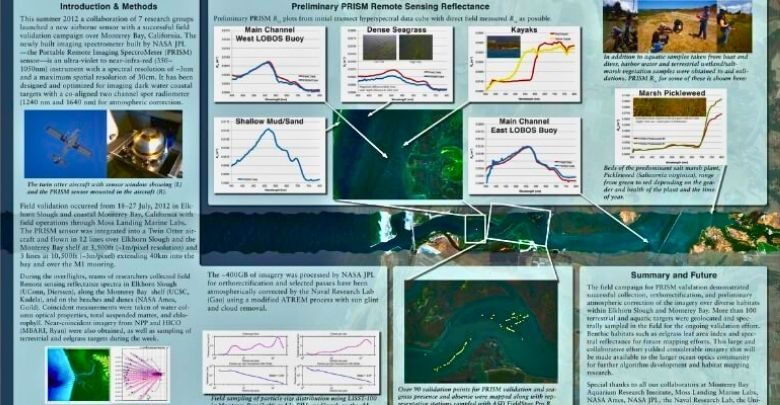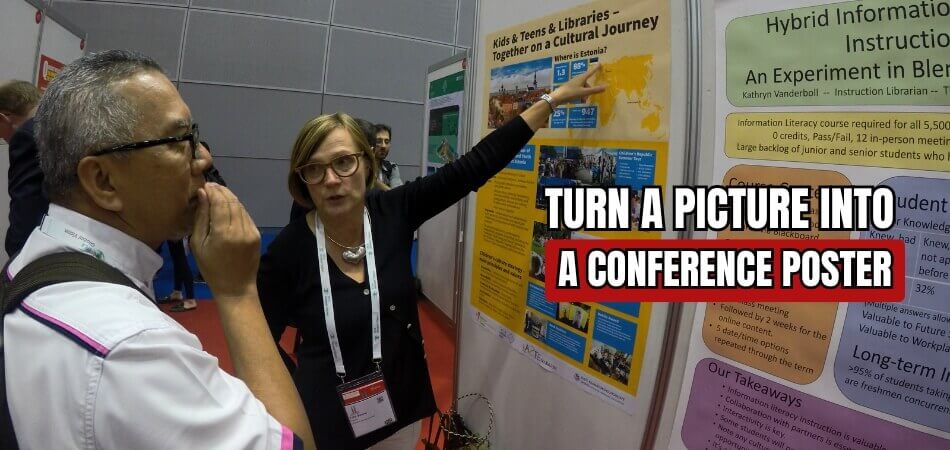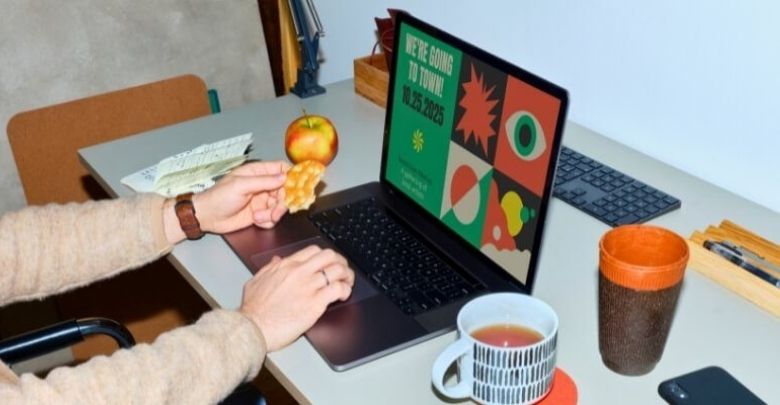Creating a visually appealing conference poster is essential for capturing attention. An appealing design grabs viewers in, making it easier for them to engage with your research, which leads to the question: Can you turn a picture into a conference poster?
Yes, you can turn a picture into a powerful conference poster. Using a picture as the focal point combines strong visuals with concise text to create an engaging presentation. A good quality image, relevant details, and clear layout allow viewers to understand complex ideas instantly, making your research memorable and approachable.
Curious about how to maximize the impact of your poster design? This article covers everything you need to know, from essential design principles to common mistakes to avoid. Dive in to find valuable insights that will help make your poster stand out in any conference.
What Makes a Good Conference Poster?
A good conference poster grabs attention while clearly presenting research or ideas. It should be visually appealing and easy to understand at a glance. A well-structured design with clear headings, bullet points, and high-quality visuals helps convey key information quickly. Simplicity is key to making an effective poster stand out.
Choosing the right font size and color scheme is important for readability. Text should be large enough to read from a distance, and colors should enhance visibility without causing strain. A balanced layout with enough white space prevents clutter. Using visuals like charts and diagrams can make complex information more digestible.

Content should be concise and focused on the main message. Avoid overwhelming the reader with too much text. A strong title, a brief introduction, key findings, and a clear conclusion create a logical flow. Including contact details or a QR code for additional information allows interested viewers to learn more.
Every conference has its own standards and expectations for posters. In academic and professional events, especially in conferences in Canada, where presenters often follow specific formatting guidelines. Aligning with these standards ensures a professional presentation. Reviewing poster requirements in advance helps create a design that meets event expectations while effectively engaging the audience.
Can You Turn a Picture Into a Conference Poster?
Visual storytelling captivates audiences instantly. Using a picture as the core of your conference poster combines striking visuals with essential details, making your content unforgettable. Here is why you should use pictures for posters.

Capture Immediate Attention
Image-based posters quickly capture attention. A well-chosen picture can create instant interest, which helps draw viewers to your work. Adding a powerful image gives your poster a strong opening that engages the audience. In busy conference settings, this quick engagement is essential for making your research memorable and inviting further exploration.
Simplify Complex Ideas
Using a picture lets you convey complex ideas easily. Visuals allow attendees to grasp difficult concepts more quickly without heavy text. An effective image reduces the need for lengthy explanations, making your message clear and accessible to a broad audience. This simplification ensures that your audience understands the core of your research without feeling overwhelmed.
Boost Memorability
Words are not as memorable to conference attendees as images. A strong picture, combined with concise text, makes your poster unforgettable. The visual elements help attendees recall your main points even after they’ve left the conference.
By making a lasting impression, your poster can generate interest in your research long after the event has concluded.
Increase Emotional Impact
Images can create strong emotional responses. A relevant picture on your poster connects with viewers on a deeper level. Emotional reactions lead to increased engagement, making people more likely to approach and discuss your work. By inspiring feelings, visuals can turn casual observers into invested participants eager to learn more about your research.
Improve Information Flow
Using images can improve the overall layout of your poster. Visuals guide the viewer’s eyes, helping them navigate your information effortlessly. A well-placed image improves the flow and balance of your poster, making complex data easy to digest. This organization encourages viewers to take in your content without feeling overwhelmed by text-heavy sections.
Highlight Key Points
Incorporating images allows you to spotlight crucial information effectively. A picture can complement or emphasize the main points, directing the viewer’s focus. This emphasis makes important details stand out, reinforcing your message and encouraging closer examination. When key points are highlighted visually, attendees are more likely to remember and discuss these elements later.
Facilitate Conversation
Pictures inspire questions and discussions. An appealing image can serve as a conversation starter, inviting attendees to engage with you. This visual element sparks insightful dialogue, creating opportunities for meaningful connections. Engaging in conversations not only enhances your networking but also provides feedback on your research and potential collaborations for future projects.
Reinforce Professionalism
Quality visuals elevate the professional appearance of your conference poster. Using a well-designed picture adds polish, making your work look refined and thoughtfully prepared. This professionalism reflects your dedication to detail, helping establish your credibility. A polished poster stands out in a crowded environment, making a positive impression on peers and potential collaborators.
By using a picture for your conference poster boosts visual appeal, enhances clarity, and encourages connections. Choose a strong image that aligns with your message to create a powerful and memorable presentation that stands out.
How to Convert a Picture Into a Conference Poster?
With the right approach, turning a picture into a dynamic conference poster can convey your research effectively. By highlighting key information and adding impactful visuals, your poster will stand out. Let’s explore the essential steps:
Step 1. Select a Good Quality Image
Choosing a good quality image is crucial for a successful poster. A crisp, clear photo instantly boosts the poster’s visual appeal and engages the audience, especially if you’re presenting the same poster for multiple conferences. When attendees see a high-resolution image, they’re drawn to your work, which increases its impact across various events.
Step 2. Incorporate Essential Text
Adding concise, focused text is important to convey your research highlights. Avoid clutter by summarizing core findings and using bullet points when possible. This approach maintains readability while ensuring that attendees understand your message. Well-placed text sections can enhance the impact of your visuals without overwhelming the viewer.
Step 3. Ensure Visual Balance
For a poster to be polished and professional, visual balance is essential. Placing your image and text in a way that naturally guides the eye helps attendees absorb information comfortably. When the visual flow feels right, viewers spend more time engaging with your content. Balancing elements makes your poster both inviting and easy to navigate.
Step 4. Use Contrasting Colors
Applying contrasting colors improves readability and visual appeal. Background colors should enhance, not overpower, your image and text. Good color choices draw attention without distracting from your message, creating a visually attractive poster that leaves a lasting impression. A smart color palette also adds a professional touch to your presentation.
Step 5. Focus on Simplicity
A simple, clean design makes your poster approachable and clear. Avoid overcrowding with too many elements or too much text. Effective simplicity focuses the viewer’s attention and makes your message memorable. By keeping it simple, your audience can quickly grasp your research highlights and retain them.
Converting a picture into a conference poster involves clear visuals, balanced elements, and focused text. By ensuring simplicity and quality, your poster can effectively communicate your work at various events, maximizing its impact.
Common Mistakes to Avoid When Turning a Picture Into a Conference Poster
Creating an effective conference poster involves careful planning and execution. Many individuals make common errors that can diminish the impact of their work. By recognizing and avoiding these pitfalls, presenters can enhance their overall presentation experience.
- Overloading Information: Including too much text or too many visuals can overwhelm viewers. A poster should present key points clearly, allowing the audience to grasp the message quickly without feeling lost in details.
- Poor Font Choices: Selecting difficult-to-read fonts detracts from the overall message. Stick to clean, legible fonts in appropriate sizes to ensure the audience can easily read all the text from a distance.
- Ignoring Layout Balance: A messy or unbalanced layout can confuse viewers. Organizing sections with clear headings and adequate spacing makes it easier for the audience to navigate the poster effectively.
- Neglecting Visuals: Failing to include relevant visuals can make a poster less engaging. Quality images, graphs, or charts can illustrate important points and enhance understanding, capturing the audience’s attention.
- Using Inconsistent Styles: Mixing different design styles can create visual chaos. Maintaining consistent colors, fonts, and sizes throughout the poster helps create a professional appearance and enhances coherence in the message.
- Forgetting the Audience: Not considering the audience’s knowledge level can lead to misunderstandings. Tailoring content to the expected audience ensures that the poster remains relevant and informative without being overly complex.
- Overlooking Proofreading: Skipping the proofreading stage can result in embarrassing errors. Carefully reviewing the text helps catch typos or grammatical mistakes that could undermine the presenter’s credibility and professionalism.
Avoiding these common mistakes can significantly improve the quality and effectiveness of a conference poster. Focusing on clarity, layout, and audience engagement will help ensure that the poster successfully communicates its message and leaves a lasting impression.
Essential Design Principles for Conference Posters
To create a conference poster that makes an impression, one must comprehend the fundamentals of effective design. Achieving this not only showcases your research but also enhances audience engagement. Without diving into specifics, let’s explore fundamental principles.
Harmonious Composition
Achieving balance in your design creates a visually appealing experience. By combining various components for conference posters in a balanced manner ensures that each element complements the others. This thoughtful arrangement directs the viewer’s attention smoothly from one section to another, improving overall clarity and visual appeal throughout the poster.
Dynamic Contrast
Using contrast effectively can make your presentation stand out significantly. Thoughtful selection of colors and fonts ensures that important elements pop and catch the eye. When designed correctly, this contrast not only draws attention but also improves readability, allowing viewers to engage with the content from a distance.
Strategic Use of Space
One effective design element that improves clarity is negative space. Effectively utilizing space helps to reduce clutter, making important information more prominent. In the context of conference posters, this strategic use of space significantly improves readability and viewer focus, guiding the audience through the content logically and effortlessly.
Visual Hierarchy
Establishing a clear hierarchy is essential for prioritizing information effectively. This approach ensures that key findings and data stand out prominently, making the viewing experience intuitive and engaging. By structuring content according to importance, you guide the viewer’s attention and enhance their understanding of your research.
Consistency
Maintaining consistency in design elements fosters a cohesive and professional look. Adhering to a consistent theme across various components ensures that the design supports the content without overshadowing it. This attention to detail enhances the overall presentation and reflects your dedication to the project.
Designing a conference poster is an art that combines various principles to communicate research effectively. These fundamental guidelines help in creating a poster that is not only informative but also engaging, ensuring that your work leaves a lasting impression on the conference attendees.
Frequently Asked Questions (FAQs)
Creating a conference poster from a picture can be an exciting way to communicate research visually. With the right approach, it becomes a compelling medium to convey complex ideas quickly and memorably. Below are some frequently asked questions to help guide you through this process.
How Do I Choose The Right Picture For A Conference Poster?
Choosing the right picture involves selecting one that represents your research accurately and draws the viewer’s attention. Ensure it is high-quality, relevant, and enhances the story you want to tell. A strong picture can set the tone for your poster, making it memorable and impactful.
Should I Use Text With The Picture On My Poster?
Yes, using text with your picture is essential for providing context and highlighting key points. Adding concise, focused text improves clarity and ensures viewers grasp your main message. Balance is key, as too much text can distract, while too little might leave viewers with questions.
Can I Use Multiple Pictures On A Conference Poster?
Yes, you can use multiple pictures, but it’s important not to overwhelm the layout. Each picture should serve a distinct purpose, such as illustrating specific points or supporting different sections. Ensure that the images work together cohesively to maintain a clear and visually appealing presentation.
What’s The Best Way To Arrange A Picture On A Poster?
Arranging the picture in a prominent location helps attract attention. Placing it centrally or near the top can guide the viewer’s eye naturally. Pairing it with strategically placed text and supporting visuals ensures your layout flows, making it easy for viewers to navigate through your information.
Can Pictures Help Simplify Complex Information?
Yes! Pictures are excellent for simplifying complex ideas, as they visually represent data or concepts that might be challenging to explain in words. By reducing the need for lengthy explanations, a well-chosen image can make your message accessible, allowing attendees to understand your work quickly.
Final Thoughts
Turning a picture into a conference poster is a creative and effective way to communicate complex research. By choosing a powerful image and pairing it with concise, supportive text, your poster can captivate viewers and convey your message clearly. So, can you turn a picture into a conference poster? Absolutely, with the right approach, it’s a winning strategy.
To make the most of your poster, ensure balance in layout, maintain visual flow, and use quality images that support your message. Remember, simplicity often has the greatest impact. Best wishes as you create a memorable conference poster that truly stands out!






